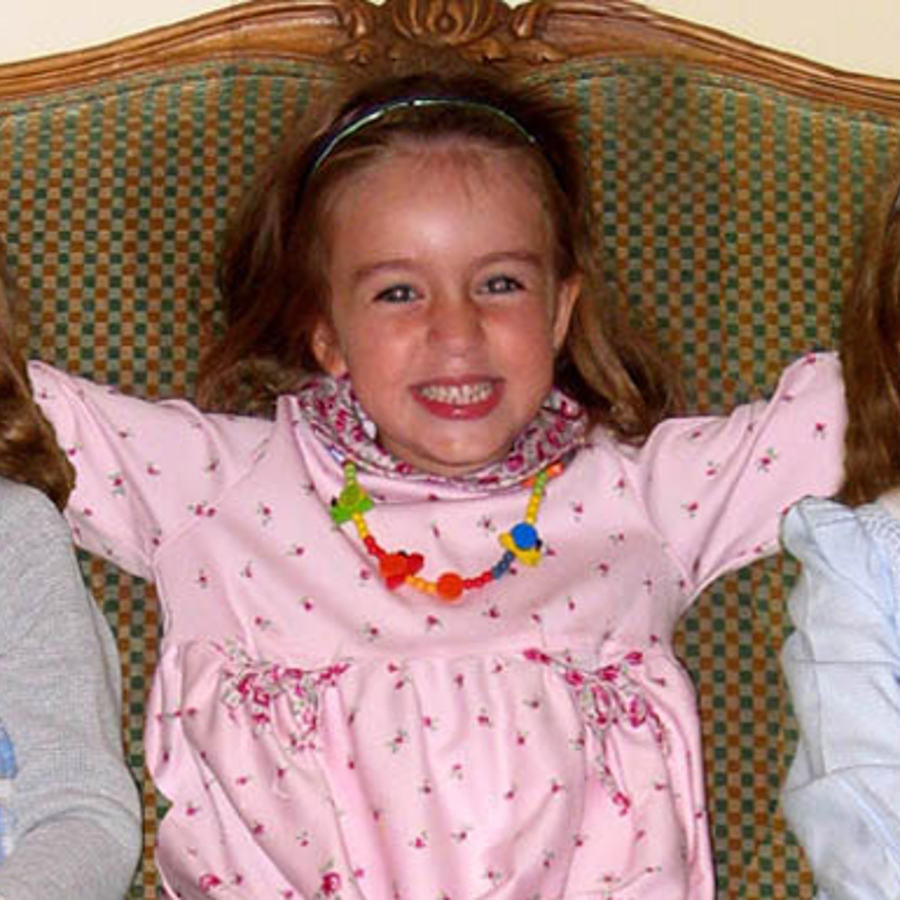
If both parents are identical twins, will their children be identical twins too?
February 16, 2016

- Related Topics:
- Twins,
- Relatedness,
- Appearance,
- Meiosis,
- Recombination
A middle school student from North Carolina asks:
"If I was an identical twin and my husband was an identical twin and we had children would our children look the same?"
The chances of the two of you having children that look identical are slim. Identical twins happen once every 250 births, and identical triplets are even less common, happening about 20-30 times per one million births.
These chances do not change just because you and your husband are identical twins. That’s because being an identical twin is not a trait that runs in families. It’s actually a random event that happens early on during pregnancy.
And the odds of them looking the same if they weren’t identical twins are really low. If they weren’t identical twins, triplets, or quadruplets, each child would have a mix of your features and your husband’s features. They might therefore look a bit like you, a bit like your husband, and a bit like each other, but they won’t look exactly the same.
What determines how your children will look, and why identical children look the same? You’ll see that it has to do with an important molecule called DNA.
Seeing Double: Chromosomes and Twins
DNA is the information that makes you who you are. It is found in the cells of our bodies, the building blocks for our different body parts. DNA in skin cells makes sure our skin works properly, DNA in hair cells gives us our hair color, and so on.
DNA is organized in long pieces called chromosomes. Most cells have 23 pairs of chromosomes for a total of 46. But cells like sperm and eggs have 23 unpaired chromosomes.
When a woman becomes pregnant, the dad’s sperm fertilizes mom’s egg. The fertilized egg goes on to become an embryo, which goes on to become their baby. Because it got 23 chromosomes from the sperm and 23 chromosomes from the egg, the end result is 23 pairs of chromosomes for the total of 46.
This is why babies usually look a bit like mom and dad. They get half of mom’s and half of dad’s instructions.
Sometimes, however, something weird happens. After the fertilized egg has divided a few times to become many cells, the clump of cells can randomly split into two, three, or even four embryos that share the same DNA! This results in identical twins, triplets, and quadruplets – children who have the same DNA and thus look alike.
Scientists are still completely puzzled about why this splitting happens. So far there’s no evidence that some people have anything in their DNA that makes their embryos more likely to split. For now, identical children are thought to happen by chance.
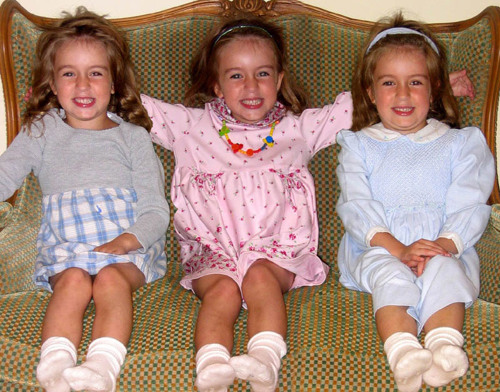
All DNA Are Not Created Equal
But you certainly don’t have to be an identical twin in order to feel unique. We all inherit a unique combination of features from our parents. And this has to do with how DNA is passed down.
As I mentioned earlier, sperm and egg cells have 23 chromosomes, instead of the usual 46. This happens through a process called meiosis.
In meiosis, each pair of chromosomes gets copied to make four chromosomes total. The four chromosomes are then divvied into four new cells like this:

Here I drew just one pair of chromosomes as bars, yellow for you and blue for your husband. You start out with a cell (a) that makes a copy of its chromosome pair (b). The cell then divides (c) and divides again (d) making four cells, each with one chromosome from the original pair.
If chromosomes really looked and got passed down this way, your children would all look alike because there is only one possible combination of chromosomes they could get. No matter which sperm combined with which egg, they’d only get the blue and yellow combination. So why doesn’t this happen in real life?
Well for starters, the two chromosomes in each pair don’t look the same. Their DNA is arranged slightly differently, to give slightly different information. So your DNA would look more like this:
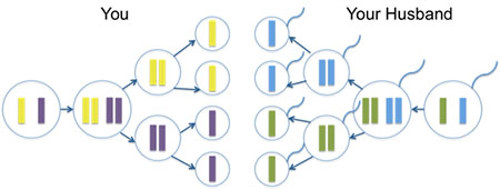
Here I colored the two chromosomes in each pair different colors to set them apart. You now have a yellow and a purple and your husband has a blue and a green.
It might seem confusing that the chromosomes in each pair are slightly different, but it’s this diversity that makes each of us unique. What ends up happening is that each of your features is encoded by two different instructions, which may add to each other (or compete with each other!).
So now you can have children who look different from each other depending on which sperm cell combines with which egg cell. The different combinations, just for this chromosome, are yellow and blue, purple and orange, yellow and orange, purple and blue.
And of course this same thing is happening with all 23 pairs of chromosomes. This already makes the odds of two siblings ending up with the same set of chromosomes 2 to the 23rd power, or about 1 in 8 million. But the odds are even worse than that!
DNA also gets mixed before it gets passed down in a process called recombination. That is, after the chromosomes are copied and before the cell divides, the four chromosomes can exchange pieces like so:
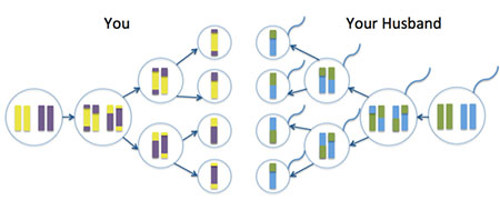
In this example, the purple and yellow chromosomes have exchanged pieces in your egg cells, and the green and blue chromosomes have exchanged pieces in your husband’s sperm cells. When sperm and egg combine, there’s even more variety in the DNA that can be passed down.
Also, I only show one possible exchange of DNA here, but a different exchange will happen the next time a cell goes through meiosis to make germ cells. Women are thought to be able to make 400 eggs, and men make tens of millions of sperm cells a day! This means the combinations of DNA for your children are endless.
This is why it’s so unlikely that two siblings who aren’t identical twins will look exactly alike. Pretty neat, considering they come from the same set of starting DNA!
Read More:
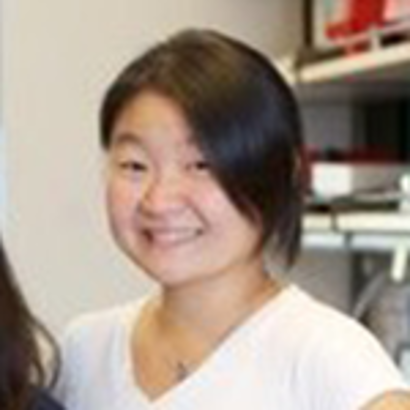
Author: Jenny Hsu
When this answer was published in 2016, Jenny was a Ph.D. candidate in the Department of Genetics, studying stem cells and regeneration in Julien Sage’s laboratory. She wrote this answer while participating in the Stanford at The Tech program.
 Skip Navigation
Skip Navigation
